The Late Jurassic–Palaeogene Carbonate Platforms in the Outer Western Carpathian Tethys—A Regional Overview
Abstract
1. Introduction
2. Material and Methods
3. Geological Background
3.1. Outline of the Outer Carpathian Geology
3.2. Distribution of the Carbonate Platform Rocks
4. Carbonate Platforms in the Outer Western Carpathians
4.1. Štramberk-Type Facies Association (Latest Jurassic–Earliest Cretaceous)
4.2. Urgonian Facies Association (Early Cretaceous)
4.3. Lithothamnion–Bryozoan Facies Association (Paleocene–Oligocene)
5. Discussion: Palaeogeography of Carbonate Platforms
5.1. Latest Jurassic–Early Cretaceous
5.2. Late Early Cretaceous
5.3. Late Cretaceous
5.4. Palaeogene
5.5. Decline of Carbonate Platforms
6. Conclusions
- During the evolution of the Outer Carpathian basins, in the shallow-water areas, the carbonate sedimentation was developed apart from the dominating clastic deposition. This is evidenced by the fragments of carbonate rocks preserved among the deep-water deposits.
- Three main shallow-water facies associations—Štramberk, Urgonian, and Lithothamnion–bryozoan—could be divided. These facies are distinct and related to different stages of the Carpathian basins’ evolution.
- The analysis of these facies allows us to distinguish several ridges covered by carbonate platforms within the Outer Carpathian Tethys and correlate them with platforms present on the Tethyan margins.
- The Tithonian–lowermost Cretaceous Štramberk facies association—the most widespread of the three described facies associations—reflects the most intense carbonate deposition that took place in the Silesian Domain during the early stages of its development. Facies-diversified, narrow, shallow-water platforms, rich in corals, sponges, green algae, echinoderms, foraminifera, microencrusters, and microbes, are typical of this stage.
- The next stage of the shallow-water carbonate deposition is noticeable in the Magura Domain. The Urgonian facies association developed mainly on the south margin of the Outer Carpathian basins and is characterised by the organodetritic limestones built of such fossils as bivalves (including rudists), larger benthic foraminifera, crinoids, echinoids, and corals.
- The Late Cretaceous is characterised by domination of siliciclastic sedimentation and limited development of carbonaceous facies on the Outer Carpathian ridges.
- Since the Paleocene, in all of the Western Outer Carpathian sedimentary area, the Lithothamnion–bryozoan facies association, adapted to unstable clastic deposits, developed. Algae–bryozoan covers originating on the siliciclastic substrate are typical of this facies association. Such type of deposition preserved practically until the final stage in the evolution of the Outer Carpathian basins.
- The ridges with carbonate platforms were destroyed during Neogene times as a result of development of the Outer Carpathian nappes.
Author Contributions
Funding
Institutional Review Board Statement
Informed Consent Statement
Data Availability Statement
Acknowledgments
Conflicts of Interest
References
- Golonka, J. Plate tectonic evolution of the southern margin of Eurasia in the Mesozoic and Cenozoic. Tectonophysics 2004, 381, 235–273. [Google Scholar] [CrossRef]
- Flügel, E. Microfacies of Carbonate Rocks; Springer: Berlin/Heidelberg, Germany, 2004; pp. 1–976. [Google Scholar]
- Handford, C.R.; Loucks, R.G.; Sarg, J.F. Carbonate Depositional Sequences and Systems Tracts—Responses of Carbonate Platforms to Relative Sea-Level Changes. In Carbonate Sequence Stratigraphy: Recent Advances and Applications; Loucks, R.G., Sarg, R., Eds.; American Association of Petroleum Geologists AAPG/Datapages: Tulsa, OK, USA, 1993; Volume 57, pp. 3–41. [Google Scholar]
- Kiessling, W.; Flügel, E.; Golonka, J. Patterns of Phanerozoic carbonate platform sedimentation. Lethaia 2003, 36, 195–225. [Google Scholar] [CrossRef]
- Ginsburg, R.N.; James, N.P. Holocene carbonate sediments of continental shelves. In The Geology of Continental Margins; Burk, C.A., Drake, C.L., Eds.; Springer: Berlin/Heidelberg, Germany, 1974; pp. 137–155. [Google Scholar]
- Read, J.F. Carbonate Platform Facies Models. AAPG Bull. 1985, 69, 1–21. [Google Scholar] [CrossRef]
- Golonka, J.; Krobicki, M.; Oszczypko, N.; Ślączka, A.; Słomka, T. Geodynamic evolution and palaeogeography of the Polish Carpathians and adjacent areas during Neo–Cimmerian and preceding events (latest Triassic–earliest Cretaceous). In Tracing Tectonic Deformation Using the Sedimentary Record; McCann, T., Saintot, A., Eds.; Geological Society Special Publication, Geological Society of London: London, UK, 2003; Volume 208, pp. 138–158. [Google Scholar]
- Golonka, J.; Gahagan, L.; Krobicki, M.; Marko, F.; Oszczypko, N.; Ślączka, A. Plate Tectonic Evolution and Paleogeography of the Circum–Carpathian Region. In The Carpathians and Their Foreland: Geology and Hydrocarbon Resources; Golonka, J., Picha, F., Eds.; American Association of Petroleum Geologists Memoir: Tulsa, OK, USA, 2006; Volume 84, pp. 11–46. [Google Scholar]
- Golonka, J.; Waśkowska, A.; Ślączka, A. The Western Outer Carpathians: Origin and evolution. Z. Dtsch. Ges. Geowiss. 2019, 170, 229–254. [Google Scholar] [CrossRef]
- Golonka, J.; Oszczypko, N.; Ślączka, A. Late Carboniferous-Neogene geodynamic evolution and paleogeography of the circum-Carpathian region and adjacent areas. Ann. Soc. Geol. Pol. 2000, 70, 107–136. [Google Scholar]
- Golonka, J. Evolution of the Outer Carpathian Basin. In Integrating Microfossil Records from the Oceans and Epicontinental Seas; Bąk, M., Kaminski, M.A., Waśkowska, A., Eds.; Grzybowski Foundation, Special Publication: Kraków, Poland, 2011; Volume 17, pp. 3–14. [Google Scholar]
- Golonka, J.; Krobicki, M. Jurassic Paleogeography of the Pieniny and Outer Carpathian Basins. Riv. Ital. DI Paléontol. E Strat. 2004, 110, 5–14. [Google Scholar] [CrossRef]
- Golonka, J. Late Devonian paleogeography in the framework of global plate tectonics. Glob. Plan. Chan. 2020, 186, 1–19. [Google Scholar] [CrossRef]
- Ślączka, A.; Kruglow, S.; Golonka, J.; Oszczypko, N.; Popadyuk, I. The General Geology of the Outer Carpathians, Poland, Slovakia, and Ukraine. In The Carpathians and Their Foreland: Geology and Hydrocarbon Resources; Golonka, J., Picha, F., Eds.; American Association of Petroleum Geologists Memoir: Tulsa, OK, USA, 2006; Volume 84, pp. 221–258. [Google Scholar]
- Oszczypko, N.; Uchman, A.; Malata, E. Palaeotectonic Evolution of the Outer Carpathian and Pieniny Klippen Belt Basins; Instytut Nauk Geologicznych UJ: Kraków, Poland, 2006; pp. 1–199. [Google Scholar]
- Hsü, K.J. Paleoceanography of the Mesozoic Alpine Tethys. Geology 1975, 3, 347–348. [Google Scholar] [CrossRef]
- Schmid, S.M.; Bernoulli, D.; Fügenschuh, B.; Matenco, L.; Schefer, S.; Schuster, R.; Tischler, M.; Ustaszewski, K. The Alpine-Carpathian-Dinaridic orogenic system: Correlation and evolution of tectonic units. Swiss J. Geosci. 2008, 101, 139–183. [Google Scholar] [CrossRef]
- Książkiewicz, M. Objaśnienia do Ogólnej Mapy Geologicznej Polski, 1: 50,000, arkusz Wadowice; Wydawnictwa Geologiczne: Warszawa, Poland, 1951; pp. 1–283. [Google Scholar]
- Słomka, T.; Malata, T.; Leśniak, T.; Oszczypko, N.; Poprawa, P. Ewolucja basenu śląskiego i podśląskiego. In Rozwój Paleotektoniczny Basenów Karpat Zewnętrznych i Pienińskiego pasa Skałkowego; Oszczypko, N., Uchman, A., Malata, E., Eds.; Instytut Nauk Geologicznych UJ: Kraków, Poland, 2006; pp. 111–126. [Google Scholar]
- Gawęda, A.; Golonka, J.; Waśkowska, A.; Szopa, K.; Chew, D.; Starzec, K.; Wieczorek, A. Neoproterozoic crystalline exotic clasts in the Polish Outer Carpathian flysch: Remnants of the Proto-Carpathian continent? Int. J. Earth Sci. 2019, 108, 1409–1427. [Google Scholar] [CrossRef]
- Gawęda, A.; Szopa, K.; Golonka, J.; Chew, D.; Waśkowska, A. Central European Variscan Basement in the Outer Carpathians: A Case Study from the Magura Nappe, Outer Western Carpathians, Poland. Minerals 2021, 11, 256. [Google Scholar] [CrossRef]
- Cieszkowski, M.; Golonka, J.; Ślączka, A.; Waśkowska, A. Role of the olistostromes and olistoliths in tectonostratigraphic evolution of the Silesian Basin in the Outer West Carpathians. Tectonophysics 2012, 568–569, 248–265. [Google Scholar] [CrossRef]
- Strzeboński, P. Late Cretaceous—Early Palaeogene sandy-to-gravelly debris flows and their sediments in the Silesian Basin of the Alpine Tethys (Western Outer Carpathians, Istebna Formation). Geol. Q. 2014, 58, 195–214. [Google Scholar] [CrossRef]
- Cieszkowski, M.; Golonka, J.; Krobicki, M.; Ślączka, A.; Oszczypko, N.; Waśkowska, A.; Wendorff, M. The Northern Carpathians plate tectonic evolutionary stages and origin of olistoliths and olistostromes. Geod. Acta 2009, 22, 101–126. [Google Scholar] [CrossRef]
- Koszarski, L.; Sikora, W.; Wdowiarz, S. The Flysch Carpathians. In Tectonics of the Carpathian-Balkan Region; Mahel, M., Ed.; Geologicky Ustav Dioniza Štura: Bratislava, Czechoslovakia, 1974; pp. 180–197. [Google Scholar]
- Książkiewicz, M. Tectonics of the Carpathians. In Geology of Poland, IV Tectonics; Pożaryski, W., Ed.; Wydawnictwa Geologiczne: Warszawa, Poland, 1977; pp. 476–604. [Google Scholar]
- Żytko, K.; Gucik, S.; Ryłko, W.; Oszczypko, N.; Zając, R.; Garlicka, I.; Nemčok, J.; Eliáš, M.; Menčík, E.; Dvořák, J.; et al. Geological map of the Western Outer Carpathians and their foreland without Quaternary formations. In Geological Atlas of the Western Outer Carpathians and Their Foreland, 1:500,000; Poprawa, D., Nemčok, J., Eds.; Państwowy Instytut Geologiczny: Warszawa, Poland, 1989. [Google Scholar]
- Picha, F.J.; Stranik, Z.; Krejci, O. Geology and Hydrocarbons Resources of the Outer Carpathians and their foreland, Czech Republic. In The Carpathians and their Foreland: Geology and Hydrocarbon Resources; Golonka, J., Picha, F., Eds.; American Association of Petroleum Geologists Memoir: Tulsa, OK, USA, 2006; Volume 84, pp. 49–175. [Google Scholar]
- Golonka, J.; Waśkowska–Oliwa, A. Stratigraphy of the Polish Flysch Carpathians between Bielsko–Biała and Nowy Targ. Kwart. AGH Geol. 2007, 33, 5–28. [Google Scholar]
- von Morlot, A. Erläuterungen zur Geologischen Übersichtskarte der Nordöstlichen Alpen. Ein Entwurf zur Vorzunehmenden Bearbeitung der Physikalischen Geographie und Geologie ihres Gebietes; Braumüller und Seidel: Wien, Austria, 1847; pp. 1–212. [Google Scholar]
- Hohenegger, L. Die geognostischen Verhältnisse der Nord.-Karpathen in Schlesien und den Angrenzenden Theilen von Mähren und Galizien Erläuterung zu der Geognostischen Karte der Nordkarpathen; Justus Perthes: Gotha, Germany, 1861; pp. 1–50. [Google Scholar]
- Golonka, J.; Krobicki, M.; Waśkowska, A.; Cieszkowski, M.; Ślączka, A. Olistostromes of the Pieniny Klippen Belt, Northern Carpathians. Geol. Mag. 2014, 152, 269–286. [Google Scholar] [CrossRef]
- Dżułyński, S.; Kotlarczyk, J. O pochodzeniu warstw popielskich w Karpatach polskich. Rocz. Pol. Tow. Geol. 1965, 35, 103–105. [Google Scholar]
- Dżułyński, S.; Kotlarczyk, J.; Ney, R. Podmorskie ruchy masowe w basenie skolskim. In Stratygrafia Formacji z Ropianki (fm). Poziomy z Olistostromami w Karpatach Przemyskich. Materialy Terenowej Konferencji Naukowej w Przemyślu, Przemyśl, Poland, 28–29 June 1979; Sekcja Sedymentologiczna PTG, IG, Instytut Geologii i Surowców Mineralnych AGH: Kraków, Poland, 1979; pp. 17–27. [Google Scholar]
- Słomka, T. Statistical approach to study of flysch sedimentation—Kimmeridgian–Hauterivian Cieszyn Beds, Polish Outer Carpathian. Ann. Soc. Geol. Pol. 1986, 56, 277–336. [Google Scholar]
- Matyszkiewicz, J.; Słomka, T. Organodetrital conglomerates with ooids in the Cieszyn Limestone (Tithonian Berriasian) of the Polish Flysch Carpathians and their palaeogeographic significances. Ann. Soc. Geol. Pol. 1994, 63, 211–248. [Google Scholar]
- Rajchel, J. Litostratygrafia osadów górnego paleocenu i eocenu jednostki skolskiej. Zesz. Nauk. AGH Geol. 1990, 48, 1–102. [Google Scholar]
- Rajchel, J.; Myszkowska, J. Exotic clasts of organodetritic algal limestones from lithosomes of the Babica Clay, Skole Unit (Outer Flysch Carpathians, Poland). Ann. Soc. Geol. Pol. 1998, 68, 225–235. [Google Scholar]
- Szymakowska, F. Płaty magurskie z okolicy Jasła oraz ich stosunek do strefy przedmagurskiej. Ann. Soc. Geol. Pol. 1966, 36, 41–63. [Google Scholar]
- Ślączka, A. Geologia jednostki dukielskiej. Pr. Inst. Geol. 1971, 63, 1–77. [Google Scholar]
- Stráník, Z.; Menčík, E.; Eliáš, M.; Adámek, J. Flyšové pásmo Západních Karpat, autochtonní mesozoikum a paleogén na Moravě a ve Slezsku. In Geologie Moravy a Slezska. Přichystal; Obstová, E., Suk, M., Eds.; Moravské Zemské Muzeum a Sekce Geologických věd PřF MU: Brno, Czech Republic, 1993; pp. 107–122. [Google Scholar]
- Menčík, E.; Adamová, M.; Dvořák, J.; Dudek, A.; Jetel, J.; Jurková, A.; Hanzlíková, E.; Houša, V.; Peslová, H.; Rybářová, L.; et al. Geologie Moravskoslezských Beskyd a Podbeskydské Pahorkatiny; Ústřední Ustav Geologický v Academii: Praha, Czechosłovakia, 1983; pp. 1–304. [Google Scholar]
- Strzebonski, P.; Kowal-Kasprzyk, J.; Olszewska, B. Exotic clasts, debris flow deposits and their significance for reconstruction of the Istebna Formation (Late Cretaceous—Paleocene, Silesian Basin, Outer Carpathians). Geol. Carpathica 2017, 68, 562–582. [Google Scholar] [CrossRef]
- Olszewska, B.; Wieczorek, J. Jurassic sediments and microfossils of the Andrychów Klippes (Outer Western Carpathians). Geol. Carpath. 2001, 52, 217–228. [Google Scholar]
- Olszewska, B.; Paul, Z.; Ryłko, W.; Garecka, M. Biostratygrafia Olistolitów Wapiennych Zewnętrznego Pasa Skałkowego Karpat i skał Otaczających; ALM studio-Paul Hupper: Kraków, Poland, 2011; pp. 1–93. [Google Scholar]
- Kowal-Kasprzyk, J.; Krajewski, M.; Gedl, P. The oldest stage of the Outer Carpathian evolution in the light of Oxfordian–Kimmeridgian exotic clast studies (southern Poland). Facies 2020, 66, 1–23. [Google Scholar] [CrossRef]
- Hoffmann, M.; Kołodziej, B.; Kowal-Kasprzyk, J. A lost carbonate platform deciphered from clasts embedded in the flysch: Štramberk-type limestones, Polish Outer Carpathians. Ann. Soc. Geol. Pol. 2021. accepted. [Google Scholar]
- Hoffmann, M.; Kołodziej, B.; Skupien, P. Microencruster-microbial framework and synsedimentary cements in the Štramberk Limestone (Carpathians, Czech Republic): Insights into reef zonation. Ann. Soc. Geol. Pol. 2017, 87, 325. [Google Scholar] [CrossRef][Green Version]
- Kołodziej, B. Geological context and age of the Štramberk-type limestones from the Polish Outer Carpathians: An overview. Neues Jahrb. Geol. Palaontol.—Abh. 2015, 276, 173–179. [Google Scholar] [CrossRef]
- Morycowa, E. Klippes of Kruhel Wielki. In Przewodnik LIX Zjazdu Polskiego Towarzystwa Geologicznego Przemyśl; Kotlarczyk, J., Pękala, K., Gucik, S., Eds.; Wydawnictwa AGH: Kraków, Poland, 1988; pp. 16–18. [Google Scholar]
- Ciborowski, T.; Kołodziej, B. Tithonian–Berriasian calpionellids from the Štramberk-type limestones, Polish Flysch Carpathians. Geol. Carpath. 2001, 52, 343–348. [Google Scholar]
- Kowal-Kasprzyk, J. Calpionellid zones of the Tithonian–Berriasian exotic limestone clasts from the Outer Carpathians, Poland. Cretac. Res. 2018, 81, 36–50. [Google Scholar] [CrossRef]
- Kowal-Kasprzyk, J. Micropaleontological Description of Exotics of the Mesozoic Calcareous Rocks from the Silesian Nappe between the Soła and Dunajec Rivers. Ph.D. Thesis, Jagiellonian University, Kraków, 2016. [Google Scholar]
- Ivanova, D.; Kołodziej, B. Late Jurassic–Early Cretaceous foraminifera from Štramberk-type limestones, Polish Outer Carpathians. Stud. Univ. Babeş—Bolyai Geol. 2010, 55, 3–31. [Google Scholar] [CrossRef]
- Houša, V.; Vašíček, Z. Ammonoidea of the Lower Cretaceous deposits (Valanginian, Hauterivian) from Štramberk, Czech Republic. Geolines 2005, 18, 7–58. [Google Scholar]
- Vašíček, Z.; Skupien, P.; Jagt, J.W.M. Current knowledge of ammonite assemblages from the Štramberk Limestone (Tithonian-Lower Berriasian) at Kotouč Quarry, Outer Western Carpathians (Czech Republic). Cretac. Res. 2018, 90, 185–203. [Google Scholar] [CrossRef]
- Hoffmann, M.; Kołodziej, B. Zróżnicowanie facjalne wapieni typu sztramberskiego z polskich Karpat fliszowych. Kwart. AGH Geol. 2008, 34, 176–177. [Google Scholar]
- Golonka, J.; Krobicki, M.; Waśkowska-Oliwa, A.; Słomka, T.; Skupien, P.; Vašíček, Z.; Cieszkowski, M.; Ślączka, A. Lithostratigraphy of the Upper Jurassic and Lower Cretaceous deposits of the western part of Outer Carpathians (discussion proposition). Kwart. AGH Geol. 2008, 34, 9–31. [Google Scholar]
- Hohenegger, L. Aus einem von Herr Dir. L. Hohenegger aus Teschen an Herrn Bergrat Haidinger gerichtetem Schreiben. Berl. Page: 24 Mitteillungen Freunden Nat. Wien 1849, 5, 115–126. [Google Scholar]
- Eliáš, M.; Eliášová, H. Facies and palaeogeography of the Jurassic in the western part of the Outer Flysch Carpathians in Czechoslovakia. Sbor. Gel. Vĕd 1984, 39, 105–170. [Google Scholar]
- Zeuschner, L. Geognostische Beschreibung des Nerineen-Kalkes von Inwałd und Roczyny. Éditeur non identifié 1849, 3, 133–146. [Google Scholar]
- Uhlig, V. Über die Klippen der Karpathen. In Congres Géologique International. Compte Rendu de la IX. Session, Vienne, Austria 1903, Premier Fascicule; Imprimerie Hollinek Fréres: Vienne, Austria, 1904; pp. 427–453. [Google Scholar]
- Burtan, J.; Chowaniec, J.; Golonka, J. Preliminary results of studies on exotic carbonate rocks in the western part of the Polish Flysch Carpathians. Biul. Inst. Geol. 1984, 346, 147–156. [Google Scholar]
- Boorová, D.; Skupien, P.; Vašíček, Z. Chlebovické slepence v profilu Ondřejnice u Hukvald (cenoman, bašský vývoj slezské jednotky, vnější Západní Karpaty). Sbor. Věd. Prací Vys. Šk. báň. TU, Ř.horn.-geol., monog. 2003, 8, 95–106. [Google Scholar]
- Cieszkowski, M. Michalczowa zone: A new unit of fore-Magura zone, Outer Carpathians, South Poland. Kwart. AGH Geol. 1992, 18, 1–125. [Google Scholar]
- Cieszkowski, M.; Waśkowska, A.; Kowal-Kasprzyk, J.; Golonka, J.; Słomka, T.; Ślączka, A.; Wójcik-Tabol, P.; Chodyń, R. The Upper Cretaceous Ostravice Sandstone in the Polish sector of the Silesian Nappe, Outer Western Carpathians. Geol. Carpathica 2016, 67, 149–166. [Google Scholar] [CrossRef]
- Niedźwiedzki, J. Spostrzeżenia geologiczne w okolicach Przemyśla. Kosmos 1876, 1, 317–325. [Google Scholar]
- Wójcik, K. Exotica fliszowe Kruhela Wielkiego koło Przemyśla. Spraw. Kom. Fizjogr. PAU 1907, 42, 3–24. [Google Scholar]
- Bukowy, S. Sedymentacja babickich warstw egzotykowych w Karpatach Przemyskich. Rocz. PTG 1957, 26, 47–155. [Google Scholar]
- Szymakowska, F. Nowy punkt z utworami „paleocenu” z jednostki skolskiej w Kamienicy Dolnej i Gorzejowej. Kwart. Geol. 1961, 5, 313–630. [Google Scholar]
- Nowak, W. Wstępne wyniki badań egzotyków warstw inoceramowych serii skolskiej z niektórych stanowisk Karpat przemyskich i birczańskich. Kwart. Geol. 1963, 7, 421–430. [Google Scholar]
- Łapcik, P.; Kowal-Kasprzyk, J.; Uchman, A. Deep-sea mass-flow sediments and their exotic blocks from the Ropianka Formation (Campanian-Paleocene) in the Skole Nappe: A case from the Wola Rafałowska section (SE Poland). Geol. Quart. 2016, 60, 301–316. [Google Scholar]
- Burtan, J.; Sokołowski, S. Nowe badania nad stosunkiem regionu magurskiego do krośnieńskiego w Beskidach Zachodnich. Prz. Geol. 1956, 4, 457–458. [Google Scholar]
- Boué, A. Geognostisches Gemälde von Deutschland. Mit Rücksicht auf die Gebirgs-Beschaffenheit Nachbarlicher Staaten; C. Herrmann’sche Buchhandlung: Frankfurt am Main, Germany, 1829; pp. 1–623. [Google Scholar]
- Boué, A. Résumé des observations sur l’age relatif des dépots secondaires dans les Alpes et les Carpathes. Jour. Géol. 1830, 1, 50–86. [Google Scholar]
- Stráník, Z. Tectonic structure of the southern part of the Zdanice unit. Geol. práce, Správy 1963, 28, 155–160. [Google Scholar]
- Řehánek, J. Facial development and biostratigraphy of the Ernstbrunn Limestones (Middle to Upper Tithonian, Southern Moravia. Geol. Práce Správy 1987, 87, 27–60. [Google Scholar]
- Eliáš, M. Sedimentology of the Klentnice formation and the Ernstbrunn Limestone. Věst. Ústř. Úst. Geol. 1992, 6, 179–196. [Google Scholar]
- Zeiss, A. Die Ammonitenfauna der Tithonklippen von Ernstbrunn, Niederösterreich. Neu. Denkschr. Naturhist. Mus. Wien. Neue Ser. 2001, 6, 1–117. [Google Scholar]
- Stráník, Z.; Bubík, M.; Čech, S.; Švábenická, L. The Upper Cretaceous in South Moravia. Věs. Čes. Geol. Úst. 1996, 71, 1–30. [Google Scholar]
- Pícha, F.; Hanzlíková, E. Die Juraklippen in der Ždánice-Einheit bei Zaječí. Věs. Čes. Geol. Úst. 1965, 40, 175–179. [Google Scholar]
- Książkiewicz, M. On the origin of the Cieszyn Limestone in the Carpathian Flysch. Bull. l’Acad. Pol. Sci. Sér. Sci. Géol. Géograph. 1971, 19, 131–136. [Google Scholar]
- Olszewska, B. Microfossils of the Cieszyn Beds (Silesian Unit, Polish Outer Carpathians): A thin sections study. Pol. Geol. Inst. Sp. Pap. 2005, 19, 1–58. [Google Scholar]
- Waśkowska-Oliwa, A.; Krobicki, M.; Golonka, J.; Słomka, T.; Ślączka, A.; Doktor, M. Sections of the oldest sedimentary rocks in Polish Flysch Carpatians as geotouristic objects. Kwart. AGH Geol. 2008, 34, 83–121. [Google Scholar]
- Oszczypko, N. Exotic rocks in the Palaeogene of the Magura Nappe between the Dunajec and Poprad rivers. Ann. Soc. Geol. Pol. 1975, 45, 403–431. [Google Scholar]
- Mišík, M.; Sýkora, M.; Jablonský, J. Strihovské zlepence a juhomagurská kordilera. Záp. Karp. Sér. Geol. 1991, 14, 7–72. [Google Scholar]
- Oszczypko, N.; Oszczypko-Clowes, M.; Salata, D. Exotic rocks of the Krynica Zone (Magura Nappe) an their paleogeographic significance. Kwart. AGH, Geol. 2006, 32, 21–45. [Google Scholar]
- Oszczypko, N.; Oszczypko-Clowes, M.; Olszewska, B. Geological setting and lithological inventory of the Czarna Woda conglomerates (Magura Nappe, Polish Outer Carpathians). Acta Geol. Pol. 2020, 70, 397–418. [Google Scholar]
- Olszewska, B.; Oszczypko, N. The geological position, sedimentary record and composition of the Tylicz Conglomerate (Late Eocene-Oligocene): Stratigraphical and paleogeographical implications (Magura Nappe, Polish Outer Carpathians). Geol. Carpathica 2010, 61, 39–54. [Google Scholar] [CrossRef]
- Mišík, M.; Jablonský, J.; Fejdi, P.; Sýkora, M. Chromian and ferrian spinels from Cretaceous sediments of the West Carpathians. Miner. Slov. 1980, 12, 209–228. [Google Scholar]
- Mišík, M.; Sýkora, M. Der pieninische exotische Rücken, rekonstruiert aus Geröllen karbonatischer Gesteine kretazischer Konglomerate der Klippenzone und der Manín-Einheit. Záp. Karp. Sér. Geol. 1981, 7, 7–111. [Google Scholar]
- Mišík, M. Urgonian facies in the West Carpathians. Knihov. Zemn. Plynu Nafty 1990, 9a, 25–54. [Google Scholar]
- Krobicki, M.; Olszewska, B. Urgonian-type microfossils in exotic pebbles of the Late Cretaceous and Paleogene gravelstones from the Sromowce and Jarmuta formations (Pieniny Klippen Belt, Polish Carpathians). Stud. Geol. Pol. 2005, 124, 215–233. [Google Scholar]
- Michalík, J. Lower Cretaceous carbonate platform facies, Western Carpathians. Palaeogeog. Palaeoclim. Palaeoecol. 1994, 111, 263–277. [Google Scholar] [CrossRef]
- Lefeld, J. Stratigraphy and paleogeography of the High-Tatric Lower Cretaceous in the Tatra Mountains. Stud. Geol. Pol. 1968, 24, 1–115. [Google Scholar]
- Birkenmajer, K.; Dudziak, J.; Jednorowska, A.; Kutyba, J. Foraminiferal-nannoplankton evidence for Maastrichtian and Paleocene ages of the Jarmuta Formation: Its bearing on dating Laramian orogeny in the Pieniny Klippen Belt, Carpathians. Bull. Pol. Acad. Sci. Earth Sci. 1987, 35, 287–298. [Google Scholar]
- Birkenmajer, K. Jurassic and Cretaceous lithostratigraphic units of the Pieniny Klippen Belt, Carpathians, Poland. Stud. Geol. Pol. 1977, 45, 1–147. [Google Scholar]
- Oszczypko, N.; Oszczypko-Clowes, M. Geological Map of the Małe Pieniny Mts. and adjoining part of the Sądecki Ridge (Polish Outer Carpathians); “GEOPROFIL” Sp. z o.o.: Kraków, Poland, 2017. [Google Scholar]
- Oszczypko, N.; Oszczypko-Clowes, M. Geological structure and evolution of the Pieniny Klippen Belt to the east of the Dunajec River—a new approach (Western Outer Carpathians, Poland). Geol. Quart. 2014, 58, 737–758. [Google Scholar]
- Golonka, J. Division Chlorophyta and Rhodophyta. In Geology of Poland III: Atlas of Guide and Characteristic Fossils Part 2c, Mesozoic, Cretaceous; Malinowska, L., Ed.; Wydawnictwa Geologiczne: Warszawa, Poland, 1989; pp. 116–117. [Google Scholar]
- Leszczyński, S.; Kołodziej, B.; Bassi, D.; Malata, E.; Gasiński, M.A. Origin and resedimentation of rhodoliths in the Late Paleocene flysch of the Polish Outer Carpathians. Facies 2012, 58, 367–387. [Google Scholar] [CrossRef]
- Bieda, F. Sur un facies calcaire dans l’Éocene supérieur du Flysch des Karpates Polonaises. Ann. Soc. Geol. Pol. 1962, 32, 401–410. [Google Scholar]
- Bieda, F. Formacja numulityczna w Zachodnich Karpatach fliszowych. Ann. Soc. Geol. Pol. 1968, 38, 233–274. [Google Scholar]
- Bassi, D.; Kołodziej, B.; Machaniec, E.; Polak, A. Coralline algal limestones and rhodoliths from olisthostromes of the Krosno Beds (Oligocene, Polish Flysch Carpathians)—preliminary results. Slov. Geol. Mag. 2000, 2–3, 307. [Google Scholar]
- Leszczyński, S. Algal limestones and rhodolites from Ciężkowice sandstone of the Silesian Unit, Polish Carpathians. Ann. Soc. Geol. Pol. 1978, 25, 150–158. [Google Scholar]
- Waśkowska, A.; Cieszkowski, M.; Golonka, J.; Kowal-Kasprzyk, J. Paleocene sedimentary record of ridge geodynamics in Outer Carpathian basins (Subsilesian Unit). Geol. Carpath. 2014, 65, 35–54. [Google Scholar] [CrossRef]
- Bieda, F. Larger foraminifers of the Tatra Eocene. Prace Inst. Geol. 1963, 37, 1–137. [Google Scholar]
- Bieda, F. Egzotyki numulitowe z Karpat polskich. Ann. Soc. Geol. Pol. 1931, 7, 152–191. [Google Scholar]
- Roth, Z. Vysvětlivky k Přehledné Geologické mapě ČSSR 1:200,000 M-34-XIX Ostrava; Geofond: Praha, Czechoslovakia, 1962. [Google Scholar]
- Eliáš, M. Sedimentologie podslezské jednotky. Sp. Pap. Czech. Geol. Surv. 1998, 8, 1–148. [Google Scholar]
- Hanzlíková, E. Biostratigrafie Podmenilitového Souvrství Podslezské Jednotky; Geofond: Praha, Czechoslovakia, 1978. [Google Scholar]
- Książkiewicz, M.; Liszkowa, J. Podłoże skałek Andrychowskich. Ann. Soc. Geol. Pol. 1972, 42, 239–269. [Google Scholar]
- Cieszkowski, M.; Kysiak, T.; Szczęch, M.; Wolska, A. Geology of the Magura Nappe in the Osielec area with emphasis on an Eocene olistostrome with metabasite olistoliths (Outer Carpathians, Poland). Ann. Soc. Geol. Pol. 2017, 85, 169–182. [Google Scholar] [CrossRef][Green Version]
- Waśkowska, A.; Cieszkowski, M. Biostratigraphy and depositional anatomy of a large olistostrome in the Eocene Hieroglyphic Formation of the Silesian Nappe, Polish Outer Carpathians. Ann. Soc. Geol. Pol. 2014, 84, 51–70. [Google Scholar]
- Uhlig, V. Uber eine Mikrofauna aus dem Alttertiär de westgalizischen karpathen. Jahrb. kk geol. Reichsan. 1886, 36, 141–214. [Google Scholar]
- Sikora, W.; Żytko, K. Budowa Beskidu Wysokiego na południe od Żywca. BiuI. Inst. Geol. 1959, 141, 61–165. [Google Scholar]
- Grzybowski, J. Mikrofauna karpackiego piaskowca z pod Dukli. Rozpr. Wydz. Mat.-Przyr. Acad. Umiej. 1894, 29, 181–216. [Google Scholar]
- Śmigielska, T. Otwornice z warstw menilitowych okolic Dukli. Spraw. Pos. Kom. PAN 1961, 244–246. [Google Scholar]
- Geroch, S.; Gradziński, R. Stratygrafia serii podśląskiej żywieckiego okna tektonicznego. Ann. Soc. Geol. Pol. 1954, 24, 3–62. [Google Scholar]
- Leśniak, T.; Waśkowska-Oliwa, A. Utwory silikoklastyczne (paleogen) jednostki podśląskiej w rejonie Żywca. Kwart. AGH, Geol. 2001, 27, 51–70. [Google Scholar]
- Leśniak, T.; Cieszkowski, M.; Golonka, J.; Waśkowska-Oliwa, A. Pozycja geologiczna piaskowców z Czerwina w jednostce podśląskiej polskich Karpat fliszowych. In Wapienie Organogeniczne i Organodetrytyczne w Karpatach Zewnętrznych i ich Znaczenie dla Rekonstrukcji Paleogeograficznych Tetydy. Seminarium Naukowe, Kraków, Poland, 21 April 2005; Cieszkowski, M., Golonka, J., Eds.; Jagiellonian University: Kraków, Poland, 2005; pp. 13–18. [Google Scholar]
- Leszczyński, S.; Radomski, A. Objaśnienia do Szczegółowej mapy Geologicznej Polski 1: 50 000: Arkusz Ciężkowice; Państwowy Instytut Geologiczny: Warszawa, Poland, 1994; pp. 1–82. [Google Scholar]
- Kiessling, W. Geologic and Biologic Controls on the Evolution of Reefs. Annu. Rev. Ecol. Evol. Syst. 2009, 40, 173–192. [Google Scholar] [CrossRef]
- Philip, J.; Masse, J.P.; Camoin, G. Tethyan carbonate platforms. In The Ocean Basisns and Margins. Volume 8: The Tethys Ocean; Nairn, A.E.M., Ricou, L.-E., Vrielynck, B., Dercourt, J., Eds.; Springer, Plenum Press: New York, NY, USA, 1995; pp. 239–265. [Google Scholar]
- Golonka, J.; Edrich, M.E.; Ford, D.W.; Pauken, R.J.; Bocharova, N.Y.; Scotese, C.R. Jurassic paleogeographic maps of the world. The Continental Jurassic. Mus. North. Ariz. Bull. 1996, 60, 1–5. [Google Scholar]
- Cecca, F.; Azema, J.; Fourcade, E.; Baudin, F.; Guiraud, R.; Ricou, L.E.; De Wever, P. Early Kimmeridgian (146–144 Ma). In Atlas Tethys Palaeoenvironmental Maps; Dercourt, J., Ricou, L.E., Vrielynck, B., Eds.; Gauthier-Villars: Paris, France, 1993; pp. 97–112. [Google Scholar]
- Ksiazkiewicz, M. Les cordilleres dans les mers cretacees et paleogenes des Carpathes du nord. BSGF—Earth Sci. Bull. 1965, S7-VII, 443–455. [Google Scholar] [CrossRef]
- Słomka, T. Głębokomorska sedymentacja silikoklastyczna warstw godulskich Karpat. Preta Geol. 1995, 139, 1–132. [Google Scholar]
- Leśniak, T. Litostratygrafia i sedymentacja piaskowców z Rybia. In Sedymentacja Normalna, Katastroficzna i Wyjątkowa—Procesy i Produkty. In procedings of III Krajowe Spotkanie Sedymentologów, Sosnowiec, Poland, 12–15 September 1994; Malik, K., Zieliński, T., Lewandowski, J., Eds.; Uniwersytet Śląski: Sosnowiec, Poland, 1994; pp. 110–111. [Google Scholar]
- Jugowiec-Nazarkiewicz, M.; Jankowski, L. Biostratygrafia nanoplanktonowa margli żegocińskich; nowe spojrzenie na budowę geologiczną strefy lanckorońsko-żegocińskiej. Prz. Geol. 2001, 49, 1186–1190. [Google Scholar]
- Unrug, R. Kordyliera śląska jako obszar źródłowy materiału klastycznego piaskowców fliszowych Beskidu Śląskiego i Beskidu Wysokiego (polskie Karpaty zachodnie). Rocz. Pol. Tow. Geol. 1968, 38, 81–164. [Google Scholar]
- Książkiewicz, M. Geological Atlas of Poland: Stratigraphic and Facial Problems, Volume 13—Cretaceous and Early Tertiary in the Polish External Carpathians, Scale 1: 600 000; Instytut Geologiczny: Warszawa, Poland, 1962. [Google Scholar]
- Kiessling, W.; Flügel, E.; Golonka, J. Fluctuations in the carbonate production of Phanerozoic reefs. Geol. Soc. Lond. Spéc. Publ. 2000, 178, 191–215. [Google Scholar] [CrossRef]
- Renard, M. Chimisme de l’ocean, phenomenes geodynamiques et evolution de la biosphere. Application a la crise barremienne: “La naissance de l’ocean moderne”. Bull. CRE-Elf-Aquitaine 1986, 10, 593–606. [Google Scholar]
- Scott, R.W. Global environmental controls on Cretaceous reefal ecosystems. Palaeogeogr. Palaeoclim. Palaeoecol. 1995, 119, 187–199. [Google Scholar] [CrossRef]
- Lefeld, J. Middle-Upper Jurassic and Lower Cretaceous biostratigraphy and sedimentology of the sub-Tatric succession in the Tatra Mts (Western Carpathians). Acta Geol. Pol. 1974, 24, 277–364. [Google Scholar]
- Lefeld, J. Urgonian formation in the Carpathians. Mém. Soc. Géol. Fr. Nouv. Ser. 1988, 154, 141–145. [Google Scholar]
- Masse, J.-P.; Uchman, A. New biostratigraphic data on the Early Cretaceous platform carbonates of the Tatra Mountains, Western Carpathians, Poland. Cretac. Res. 1997, 18, 713–729. [Google Scholar] [CrossRef]
- Andrusov, D. Étude géologique de la zone des Klippes internes des Carpathes Occidentales; Geologické Práce Slovenskej Akademie Vied a Umeni: Bratislava, Slovakia, 1953; Volume 34, pp. 1–149. [Google Scholar]
- Birkenmajer, K. Significance of the Haligovce Klippe for the geology of the Pieniny Klippen Belt (Carpathians). Rocz. Pol. Tow. Geol. 1959, 29, 73–88. [Google Scholar]
- Birkenmajer, K. Pre-Eocene fold structures in the Pieniny Klippen Belt (Carpathians) of Poland. Stud. Geol. Pol. 1970, 31, 1–77. [Google Scholar]
- Birkenmajer, K. Geological guide to the Pieniny Klippen Belt; Wydawnictwa Geologiczne: Warszawa, Poland, 1979; pp. 3–236. [Google Scholar]
- Birkenmajer, K.; Lefeld, J. Exotic Urgonian limestones from the Pieniny Klippen Belt of Poland. Bull. Acad. Pol. Sci. Sci. Geol. Geogr. 1969, 17, 13–15. [Google Scholar]
- Birkenmajer, K.; Wieser, T. Exotic rock fragments from the Upper Cretaceous deposits near Jaworki, Pieniny Klippen Belt, Carpathians, Poland. Stud. Geol. Pol. 1990, 97, 7–67. [Google Scholar]
- Birkenmajer, K. Stages and structural evolution of the Pieniny Klippen Belt, Carpathians. Stud. Geol. Pol. 1986, 88, 7–32. [Google Scholar]
- Plašienka, D.; Méres, Š.; Ivan, P.; Sýkora, M.; Soták, J.; Lačný, A.; Aubrecht, R.; Bellová, S.; Potočný, T. Meliatic blueschists and their detritus in Cretaceous sediments: New data constraining tectonic evolution of the West Carpathians. Swiss J. Geosc. 2019, 112, 55–81. [Google Scholar] [CrossRef]
- Oszczypko, N.; Salata, D.; Konečný, P. Age and provenance of mica-schist pebbles from the Eocene conglomerates of the Tylicz and Krynica Zone (Magura Nappe, Outer Flysch Carpathians). Geol. Carpath. 2016, 67, 257–271. [Google Scholar] [CrossRef]
- Skoczylas-Ciszewska, K. Geology of the Żegocina Zone (Western Flysch Carpathians). Acta Geol. Pol. 1960, 4, 485–591. [Google Scholar]
- Liszkowska, J.; Morgiel, J.J. Contribution to the knowledge of the foraminifers of the Frydek type facies in the Polish Outer Carpathians. Geol. Quar. 1985, 29, 65–84. [Google Scholar]
- Gasiński, A.M. Campanian-Maastrichtian Palaeoecology and Palaeobiogeography of the Andrychów Klippe, Outer Carpathians, Poland; Wyd. UJ: Kraków, Poland, 1998; pp. 1–90. [Google Scholar]
- Brandys, J. Biostratigraphy and palaeoecology of the Upper Cretaceous Frydek-type marls from the Rajbrot tectonic window (Polish Flysch Carpathians). Slov. Geol. Mag. 2000, 6, 218–219. [Google Scholar]
- Philip, J.M.; Airaud-Crumiere, C. The demise of the rudist-bearing carbonate platforms at the Cenomanian/Turonian boundary: A global control. Coral Reefs 1991, 10, 115–125. [Google Scholar] [CrossRef]
- Camoin, G.; Bellion, Y.; Dercourt, J.; Guiraud, R.; Lucas, J.; Poisson, A.; Ricou, L.E.; Vrielynck, B. Late Maastrichtian (69.5-65 Ma). In Atlas Tethys Palaeoenvironmental Maps. Explanatory Notes; Dercourt, J., Ricou, L.E., Vrielynck, B., Eds.; Gauthier-Villars: Paris, France, 1993; pp. 179–196. [Google Scholar]
- Unrug, R. Istebna Beds—A fluxoturbidity formation in the Carpathian Flysch. Rocz. Pol. Tow. Geol. 1963, 33, 49–92. [Google Scholar]
- Perrin, S. Tertiary: The emergence of modern reef ecosystems. In Phanerozoic Reef Patterns; Kiessling, W., Flügel, E., Golonka, J., Eds.; SEPM Special Publication: Tulsa, OK, USA, 2002; Volume 72, pp. 587–621. [Google Scholar]
- Leszczyński, S. Piaskowce ciężkowickie jednostki śląskiej w polskich Karpatach: Studium sedymentacji głębokowodnej osadów gruboklastycznych. Ann. Soc. Geol. Pol. 1981, 51, 435–502. [Google Scholar]
- Strzeboński, P. Debryty kohezyjne warstw istebniańskich (senon górny-paleocen) na zachód od Skawy. Kwart. AGH, Geol. 2005, 31, 201–224. [Google Scholar]
- Buček, S.; Köhler, E. Palaeocene reef complex of the Western Carpathians. Slov. Gol. Mag. 2017, 17, 3–163. [Google Scholar]
- Decker, H.; Peresson, H. Tertiary kinematics in the Alpine–Carpathian–Pannonian system: Links between thrusting, transform faulting and crustal extension. In Oil and Gas in Alpidic Thrust Belts and Basins of Central and Eastern Europe; Wessely, G., Liebl, W., Eds.; European Association of Geoscientists and Engineers Special Publication, OMV: Vienna, Austria, 1996; Volume 5, pp. 17–21. [Google Scholar]
- Plašienka, D.; Kovač, M. How to loop Carpathians—An attempt to reconstruct Meso-Cenozoic palinspastic history of the Carpathian orocline. Geol. Carpath. 1999, 50, 163–165. [Google Scholar]
- Oszczypko, N. The Western Carpathian Foredeep—Development of the foreland basin in front of the accretionary wedge and its burial history (Poland). Geol. Carpath. 1998, 49, 415–431. [Google Scholar]
- Oszczypko, N.; Golonka, J.; Malata, T.; Poprawa, P.; Słomka, T.; Uchman, A. Tectonostratigraphic evolution of the Outer Carpathian basins (Western Carpathians, Poland). Miner. Slov. 2003, 5, 17–20. [Google Scholar]
- Dercourt, J.; Ricou, L.E.; Vrielynck, B. Atlas Tethys Paleoenvironmental Maps; Gauthier-Villars: Paris, France, 1993; pp. 1–307. [Google Scholar]
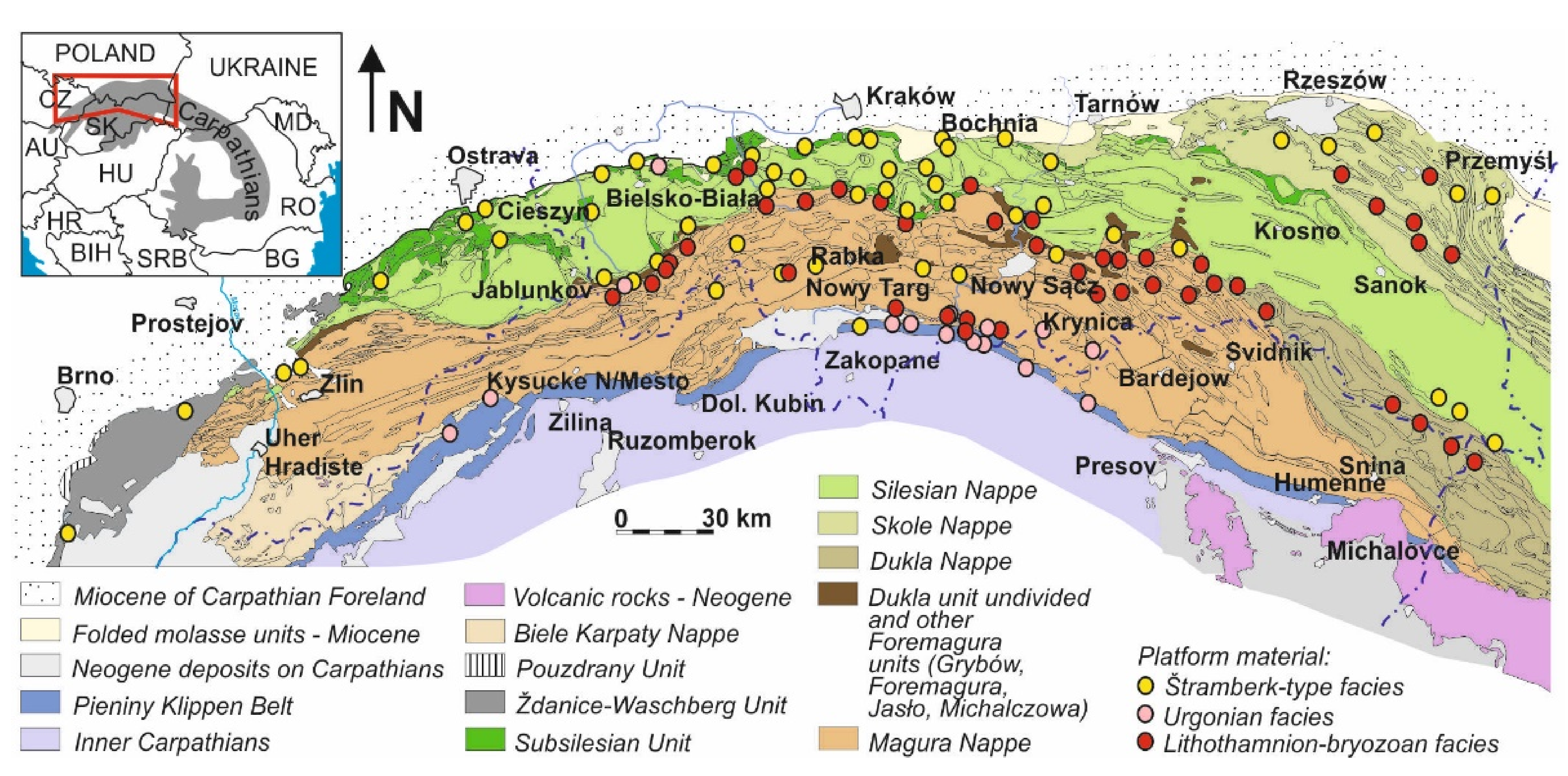
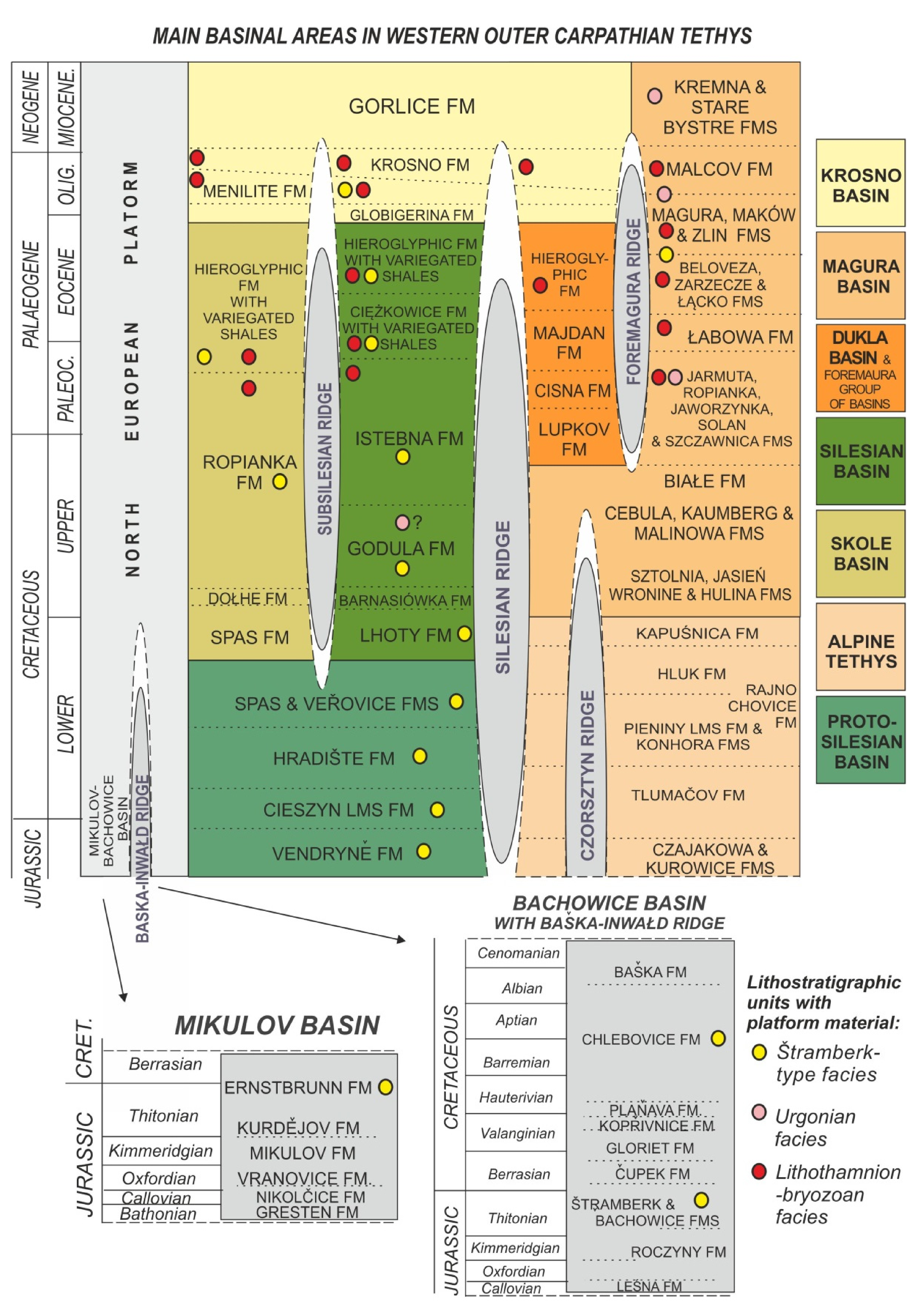
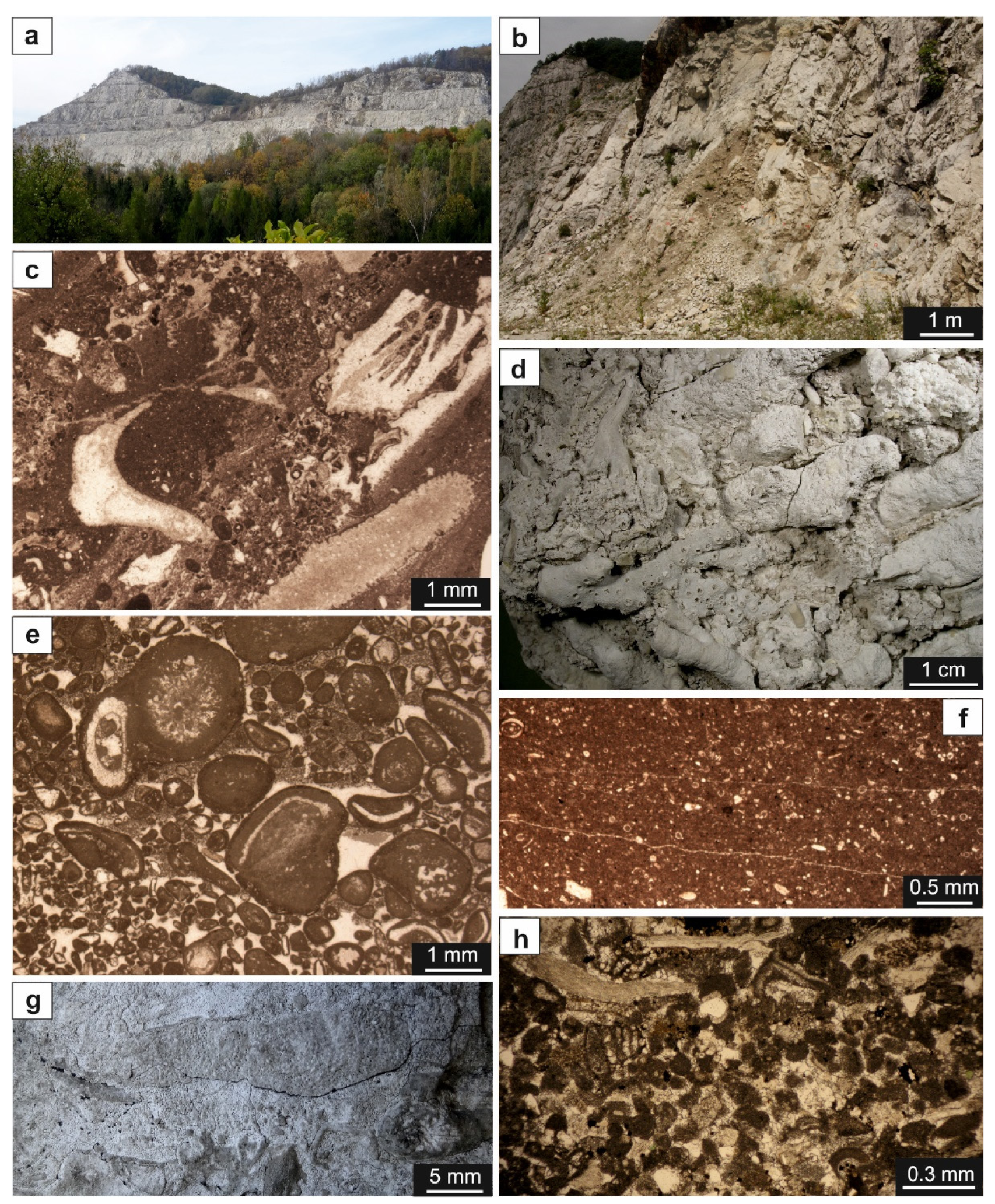
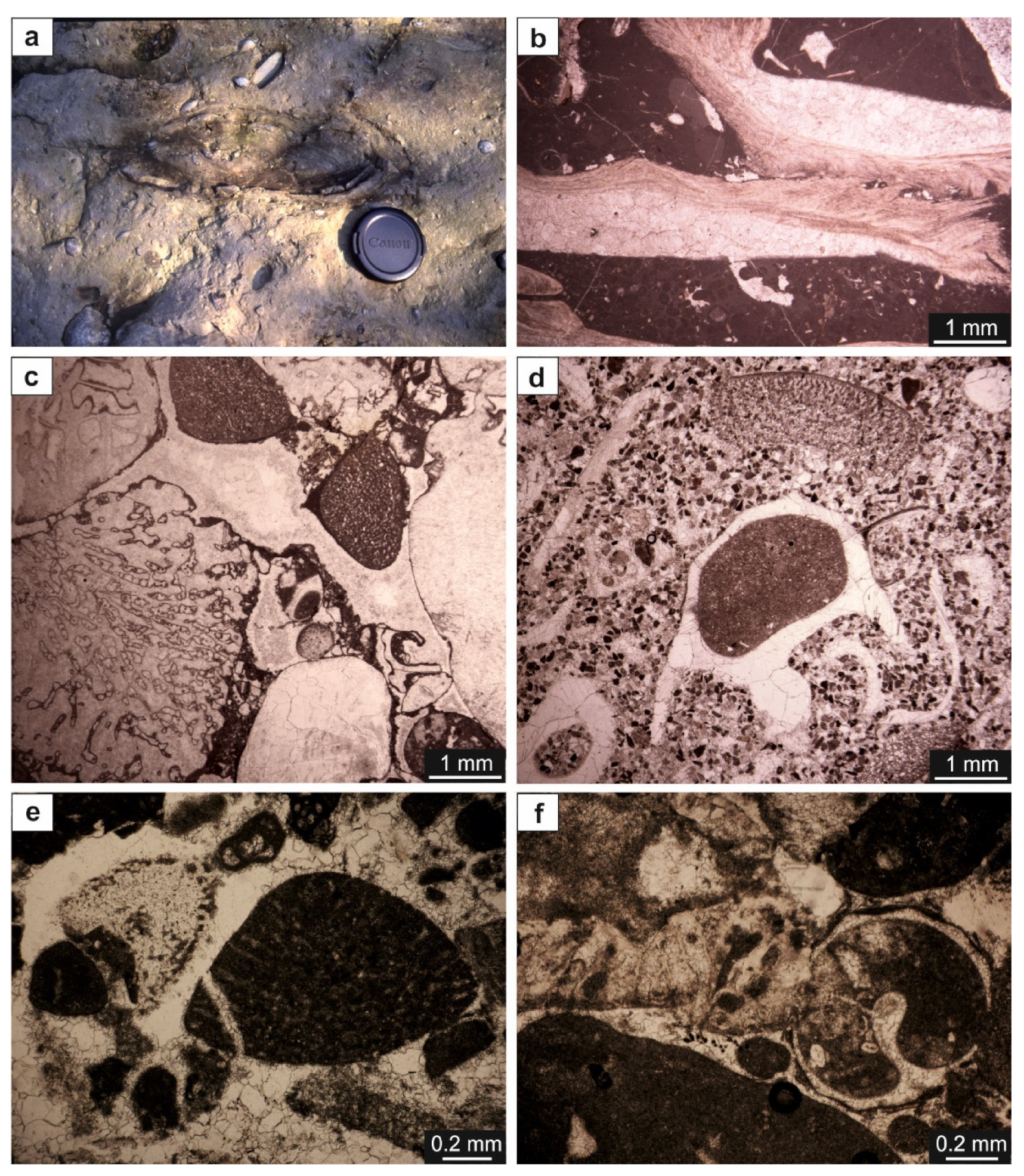
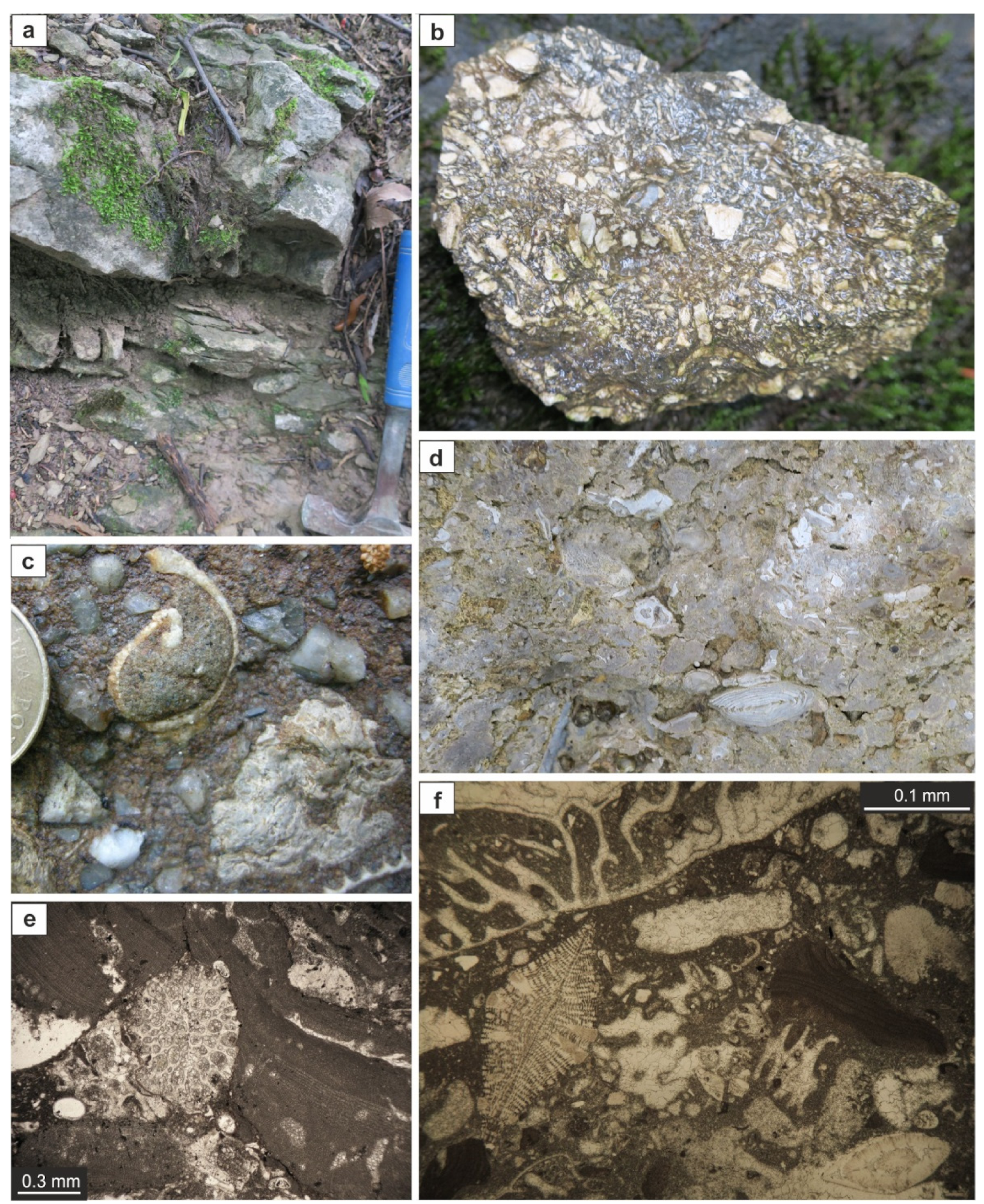
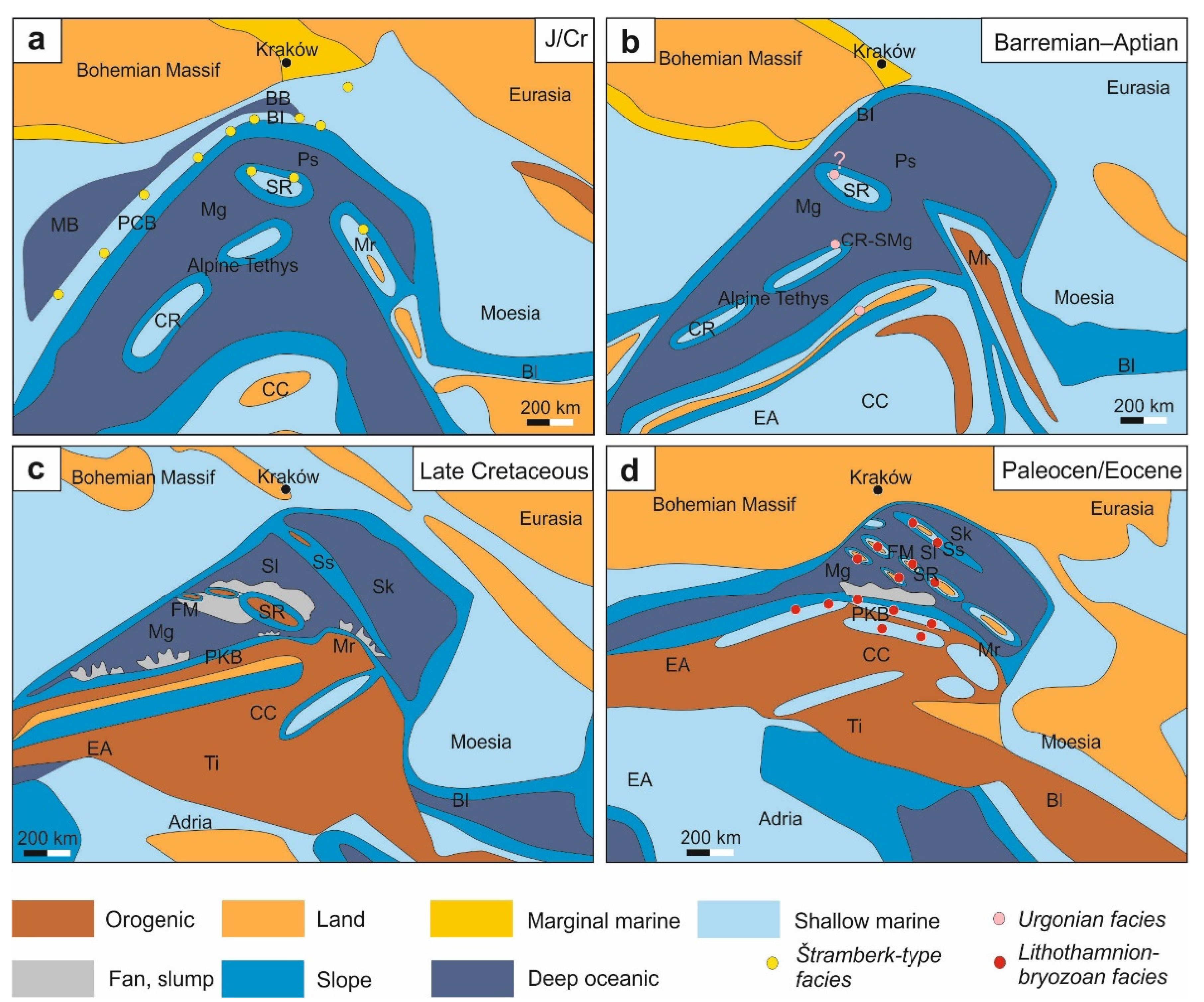
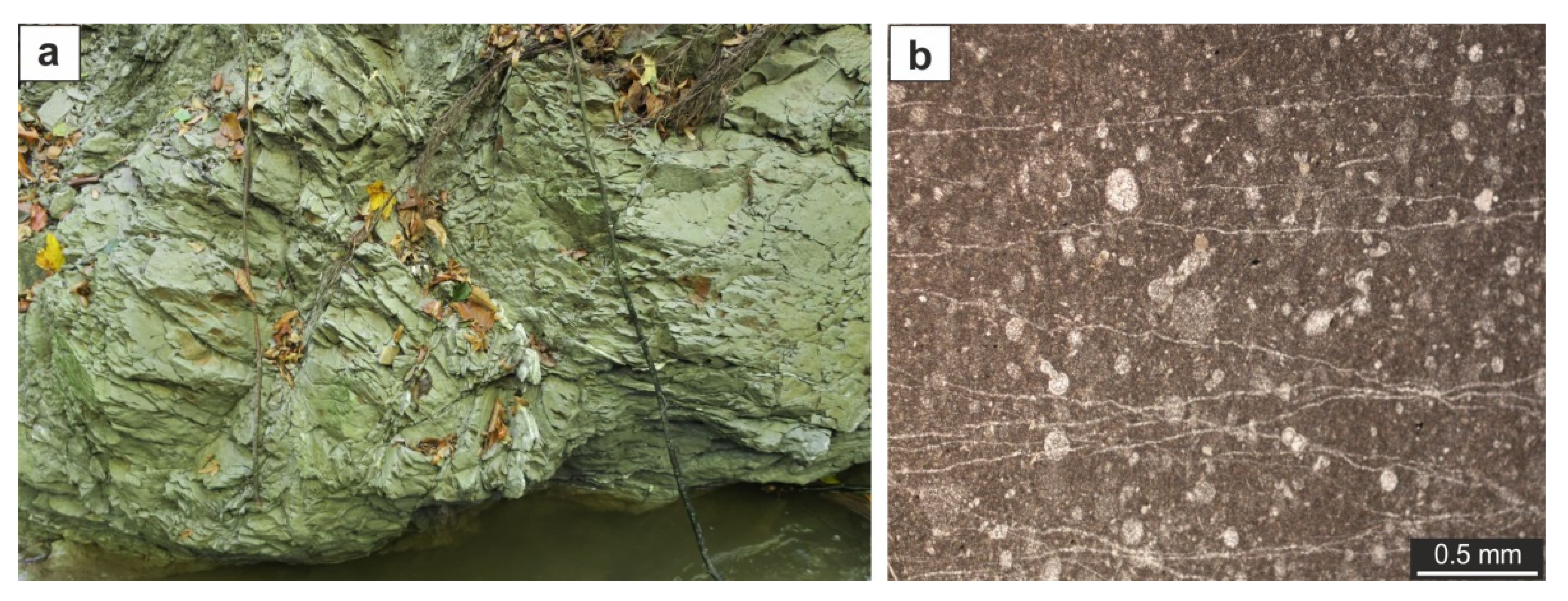
| Facies Associations | Age | Typical Components | Distribution in the Western Outer Carpathians |
|---|---|---|---|
| Štramberk-type | Tithonian–earliest Cretaceous | Corals, sponges, benthic foraminifera, microencrusters, microbes, dasycladaceans, green algae | Northern rim of the Carpathian basins, including the Baška-Inwałd Ridge, Silesian Ridge |
| Urgonian | Barremian–Aptian | Larger benthic foraminifera, bivalves (including rudists), crinoids, echinoids, corals | Southern rim of the Outer Carpathian basins (South-Magura Ridge), Silesian Ridge (?) |
| Lithothamnion–bryozoan | Paleocene–Oligocene | Coralline red algae, bryozoans, larger benthic foraminifera | Silesian Ridge Foremagura Ridge Northern rim of the Carpathian basins |
Publisher’s Note: MDPI stays neutral with regard to jurisdictional claims in published maps and institutional affiliations. |
© 2021 by the authors. Licensee MDPI, Basel, Switzerland. This article is an open access article distributed under the terms and conditions of the Creative Commons Attribution (CC BY) license (https://creativecommons.org/licenses/by/4.0/).
Share and Cite
Kowal-Kasprzyk, J.; Waśkowska, A.; Golonka, J.; Krobicki, M.; Skupien, P.; Słomka, T. The Late Jurassic–Palaeogene Carbonate Platforms in the Outer Western Carpathian Tethys—A Regional Overview. Minerals 2021, 11, 747. https://doi.org/10.3390/min11070747
Kowal-Kasprzyk J, Waśkowska A, Golonka J, Krobicki M, Skupien P, Słomka T. The Late Jurassic–Palaeogene Carbonate Platforms in the Outer Western Carpathian Tethys—A Regional Overview. Minerals. 2021; 11(7):747. https://doi.org/10.3390/min11070747
Chicago/Turabian StyleKowal-Kasprzyk, Justyna, Anna Waśkowska, Jan Golonka, Michał Krobicki, Petr Skupien, and Tadeusz Słomka. 2021. "The Late Jurassic–Palaeogene Carbonate Platforms in the Outer Western Carpathian Tethys—A Regional Overview" Minerals 11, no. 7: 747. https://doi.org/10.3390/min11070747
APA StyleKowal-Kasprzyk, J., Waśkowska, A., Golonka, J., Krobicki, M., Skupien, P., & Słomka, T. (2021). The Late Jurassic–Palaeogene Carbonate Platforms in the Outer Western Carpathian Tethys—A Regional Overview. Minerals, 11(7), 747. https://doi.org/10.3390/min11070747








